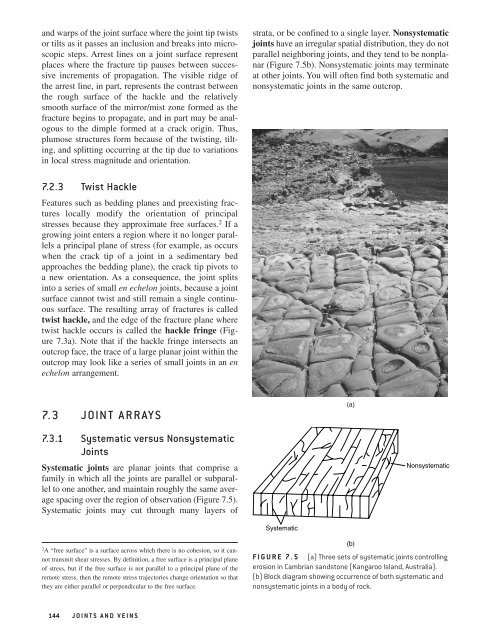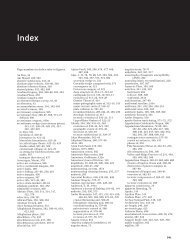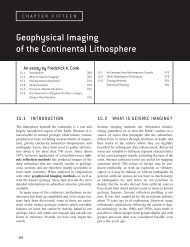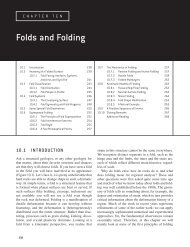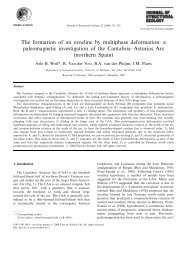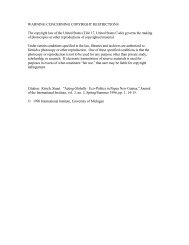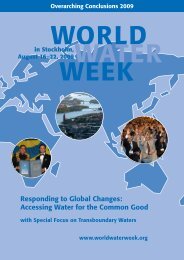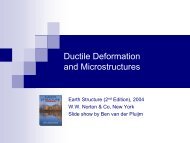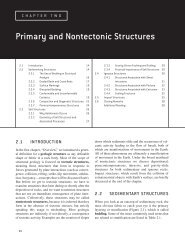Joints and Veins - Global Change
Joints and Veins - Global Change
Joints and Veins - Global Change
- No tags were found...
Create successful ePaper yourself
Turn your PDF publications into a flip-book with our unique Google optimized e-Paper software.
2917-CH07.pdf 11/20/03 5:10 PM Page 144<strong>and</strong> warps of the joint surface where the joint tip twistsor tilts as it passes an inclusion <strong>and</strong> breaks into microscopicsteps. Arrest lines on a joint surface representplaces where the fracture tip pauses between successiveincrements of propagation. The visible ridge ofthe arrest line, in part, represents the contrast betweenthe rough surface of the hackle <strong>and</strong> the relativelysmooth surface of the mirror/mist zone formed as thefracture begins to propagate, <strong>and</strong> in part may be analogousto the dimple formed at a crack origin. Thus,plumose structures form because of the twisting, tilting,<strong>and</strong> splitting occurring at the tip due to variationsin local stress magnitude <strong>and</strong> orientation.strata, or be confined to a single layer. Nonsystematicjoints have an irregular spatial distribution, they do notparallel neighboring joints, <strong>and</strong> they tend to be nonplanar(Figure 7.5b). Nonsystematic joints may terminateat other joints. You will often find both systematic <strong>and</strong>nonsystematic joints in the same outcrop.7.2.3 Twist HackleFeatures such as bedding planes <strong>and</strong> preexisting fractureslocally modify the orientation of principalstresses because they approximate free surfaces. 2 If agrowing joint enters a region where it no longer parallelsa principal plane of stress (for example, as occurswhen the crack tip of a joint in a sedimentary bedapproaches the bedding plane), the crack tip pivots toa new orientation. As a consequence, the joint splitsinto a series of small en echelon joints, because a jointsurface cannot twist <strong>and</strong> still remain a single continuoussurface. The resulting array of fractures is calledtwist hackle, <strong>and</strong> the edge of the fracture plane wheretwist hackle occurs is called the hackle fringe (Figure7.3a). Note that if the hackle fringe intersects anoutcrop face, the trace of a large planar joint within theoutcrop may look like a series of small joints in an enechelon arrangement.7.3 JOINT ARRAYS(a)7.3.1 Systematic versus Nonsystematic<strong>Joints</strong>Systematic joints are planar joints that comprise afamily in which all the joints are parallel or subparallelto one another, <strong>and</strong> maintain roughly the same averagespacing over the region of observation (Figure 7.5).Systematic joints may cut through many layers ofNonsystematicSystematic2 A “free surface” is a surface across which there is no cohesion, so it cannottransmit shear stresses. By definition, a free surface is a principal planeof stress, but if the free surface is not parallel to a principal plane of theremote stress, then the remote stress trajectories change orientation so thatthey are either parallel or perpendicular to the free surface.(b)FIGURE 7.5 (a) Three sets of systematic joints controllingerosion in Cambrian s<strong>and</strong>stone (Kangaroo Isl<strong>and</strong>, Australia).(b) Block diagram showing occurrence of both systematic <strong>and</strong>nonsystematic joints in a body of rock.144 JOINTS AND VEINS


